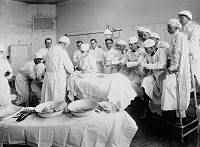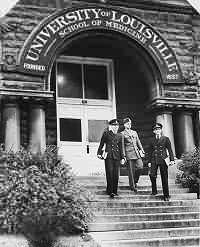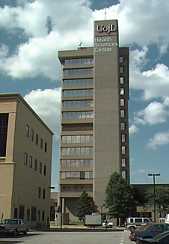History of the School of Medicine

Abell Administration Building
The University of Louisville School of Medicine is a vibrant institution with a proud heritage as one of the most comprehensive medical facilities in the southeastern United States. The school traces its beginnings to 1833, when the Louisville Common Council set up a committee to investigate the possibility of establishing a medical college in the city.
It was a boom time for Louisville, which by the early 1830s had become a burgeoning center of inland transportation. With improved river travel made possible by the steamboat, Louisville grew to be one of the largest cities in the South and sought to develop its own cultural institutions.
With the urging of community-minded citizens like town trustee James Guthrie, the city government appropriated funds for a new medical school at Eighth and Chestnut streets. The Louisville Medical Institute began classes in temporary quarters in the fall of 1837. A few weeks later, the 80 students and seven faculty members moved into a splendid Greek Revival structure designed by Kentucky architect Gideon Shryock. The school instituted clinical teaching in the wards of the public hospital, then known as the Louisville City Hospital, as an integral part of the medical curriculum. Founding faculty included several of the most distinguished professors from Lexington's Transylvania University.

Early clinical practice
By the early 1840s, the institute was flourishing. Students traveled from all over the southern and western United States to attend its lectures and clinics. Despite initial municipal funding, the school operated on a proprietary basis, enjoying considerable autonomy. The school's library was one of the finest in the country, including numerous volumes purchased in Europe. Gas lamps provided brilliant night-time lighting for specially equipped rooms. In 1846 the Louisville Medical Institute became the Medical Department of the newly formed University of Louisville. In the ensuing years of the 19th century, Louisville boasted six more medical colleges, most of which would eventually be absorbed by the University Medical Department.
Some of the best medical minds of their day taught medicine at Eighth and Chestnut and in the wards of City Hospital. Doctors such as Daniel Drake, J. Lawrence Smith, Benjamin Silliman, Charles Wilkins Short and David Wendell Yandell forged a national reputation for the school.
An adjunct to clinical teaching was the school's institution of outpatient dispensary care for indigents during the 1850-51 session. Other improvements in medical education were instituted even earlier. In 1841 Samuel D. Gross, a professor of surgery, set up one of the country's first surgical laboratories, which was used for the study of wounds in dog intestines. The school's medical practitioners then applied information gleaned from such research to the care of patients.
On Dec. 31, 1856, the institute's Greek Revival structure was destroyed by fire. Thankfully, the library and its prized contents were saved. A new building was constructed almost immediately and was ready for occupancy in 1857. The history of the structure known now as the "Old Medical School" began in April 1891 when a tract of land on the corner of First and Chestnut streets was deeded to rival Louisville Medical College. The University of Louisville acquired the building when it absorbed Louisville Medical College in 1908.

Military Personnel
at the School of Medicine
Reforms in medical education already were in progress under Dean James M. Bodine when Abraham Flexner, a Louisvillian whose brother Simon was a medical school alumnus and director of Rockefeller Institute for Medical Research, released a report on U.S. medical education that would shape the school's course for many years. Flexner's 1910 report stimulated improved curriculum, admission and graduation standards all over the United States. Local government finally saw the need for additional resources in Louisville and began to make an annual contribution to its medical school. Increased support came with the opening of a much-expanded City Hospital in 1914. The close association between the medical school and the hospital offered students an unusual breadth of practical experience.
About this time the hospital began "accident service" when, in 1911, the facility launched the nation's first trauma care center. Dr. R. Arnold Griswold refined this innovation in the 1930s and '40s with a network that served as the forerunner of Louisville's modern Emergency Medical Service and the U of L Trauma Center.
While the 1930s brought hard times to the country, the university was able to continue its expansion, and in March 1937 the medical school began laying the groundwork for a centennial celebration. Plans came to a halt, however, when the Ohio River overflowed its banks, causing the dismissal of downtown classes. Before leaving on Jan. 22, medical students moved the bulk of the library from the basement to the school's first floor. That foresight salvaged the valuable volumes. The medical school building was not structurally damaged, but classes didn't convene for two weeks. After classes resumed, it was another two weeks before utilities were fully restored.
During World War II the school negotiated a contract with the Federal government to educate students for the armed forces' medical corps. Throughout much of the 1940s, the school year consisted of two 16-week semesters, with a new class entering every nine months. New courses of instruction were introduced for orientation to military medicine, and the institution's facilities and energies were severely stretched.
These chapters in the school's history also were marked by great productivity as the school continued to extend its emphasis on hands-on clinical instruction and a growing list of specialty training programs. Then, as in every era, memorable men and women were part of the school's history. Among them were John Walker Moore, dean from 1929 to 1949; Sidney I. Kornhauser, chair of the anatomy department from 1922 to 1958; and neurosurgeon R. Glen Spurling.

HSC campus today
By 1960, the school desperately needed more space. Officials began planning to construct a modern center that would house all the university's health-related programs. The first step in that plan was the opening of the 120,000 square foot Medical-Dental Research Building in 1963 under the administration of Dean Donn Smith. Smith also coordinated the construction of new buildings to house the medical and dental schools, an adjacent library, and laboratory buildings, all of which opened in 1970 and are known collectively as the Health Sciences Center. On July 1, 1970, U of L was accepted into the Commonwealth's system of state-supported universities, and deans Douglas M. Haynes and Arthur H. Keeney spent the rest of the decade ushering in a new era of growth.
Meanwhile, at the request of Harold Boyer, vice president for health affairs, the state appropriated funds for a new teaching hospital and ambulatory care center. The hospital, operated by the non-profit University Medical Center Inc., continues to serve as the medical school's primary teaching facility, providing a full range of diagnostic, emergency, therapeutic and surgical services. The school also has strong teaching relationships with Jewish Hospital, Norton Children's Hospital, Norton Hospital, the Veterans Administration Medical Center and the James Graham Brown Cancer Center as well as numerous other facilities in the community.
The 1980s and '90s saw unprecedented growth on U of L's Health Sciences Center with the establishment of partnerships that provided unprecedented learning opportunities. Among these partnerships is Louisville Medical Center, a unique organization dedicated to leading-edge research, diagnosis and treatment. Composed of the University of Louisville Health Sciences Center, University of Louisville Hospital, Jewish Hospital, Norton Hospital, Norton Children's Hospital, the James Graham Brown Cancer and nearly 200 other partners, LMC serves more than 500,000 patients a year.
Its accomplishments are lengthy, but highlights include the nation's first successful hand transplant surgery and groundbreaking work in artificial heart transplants. Such advanced activities require equally advanced research facilities, and the university has launched an ambitious plan to make U of L's Health Sciences Center one of the country's leading institutions for medical discovery. In 1999 the university dedicated the state-of-the-art Donald E. Baxter, M.D., Biomedical Research Building, and a companion facility, the Delia B. Baxter Biomedical Research Building was dedicated in 2003.
Thanks to an infusion of money from the Kentucky General Assembly and Kentucky's Research Challenge Trust Fund, world-class researchers have begun relocating to LMC and U of L's Health Sciences Center. Between 1999 and 2006, the School of Medicine experienced the fastest growth in National Institutes of Health Research funding of any medical school in the nation.
In November, 2006 the university recruited Edward C. Halperin, M.D., M.S., F.A.C.R. to the helm of the School of Medicine. Halperin previously served as vice dean and professor of radiation oncology, pediatrics and medical education at Duke University's School of Medicine and associate vice chancellor for academic affairs at Duke's medical center. Halperin, a practicing physician in pediatric radiation oncology, continued his clinical practice at U of L's James Graham Brown Cancer Center.
Construction on campus continued, with an additional 200,000 square feet of research space under construction on the east side of the Health Sciences campus, which houses laboratories associated with the Brown Cancer Center. Construction completed in fall of 2009 on the Clinical and Translational Research Building.
Under the leadership of then-Executive Vice President for Health Affairs, Larry N. Cook, M.D., a committee composed of experts in planning, construction, education, research and clinical care completed a campus master plan designed to take the Health Science Center to the next level over the course of the next two decades. The plan was approved by the university's Board of Trustees in February, 2007.
Today, the University of Louisville School of Medicine, under the leadership of Dean Toni M. Ganzel, M.D., M.B.A., F.A.C.S., continues to educate some of the nation's finest medical practitioners. In fact, it has graduated more doctors than any other institution in the Commonwealth.
With its excellent teaching and research facilities, newly endowed chairs and strong leadership, the University of Louisville School of Medicine holds a future filled with promise, built on a past distinguished by excellence.
 Facebook
Facebook Twitter
Twitter Linkedin
Linkedin